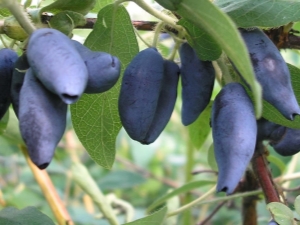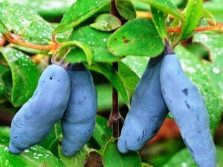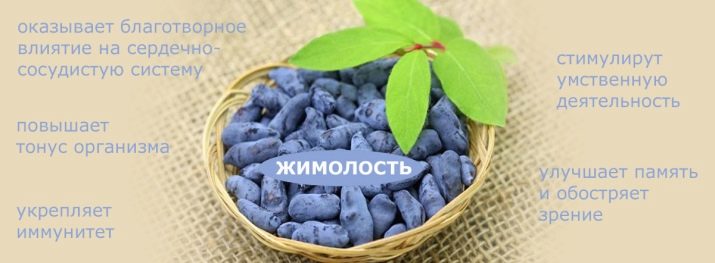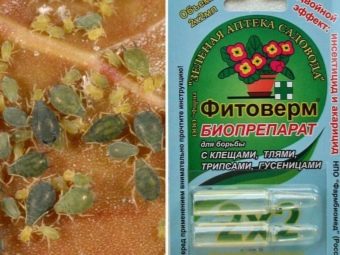Description and cultivation of a variety of honeysuckle "Yugan"

Honeysuckle "Yugan" - berry shrub, in the recent past, not having attractiveness in the eyes of gardeners due to the lack of pleasant taste.However, in the second half of the last century, the plant was cultivated. Today it is grown in different climatic zones due to unpretentiousness, high yield and healing properties. And the specific taste of the berries has noticeably changed for the better.
Characteristic
In the description of the variety "Yugana" it is said that it is a perennial shrub of medium height (up to 1.6 m), having strong branches that are bent at the tops. Honeysuckle leaves are dark green, characterized by an elongated oval shape. Despite the fact that the shrub can grow widely in width, the plant does not require pruning, as it perfectly retains the compact shape of the crown.
Culture loves loamy soils that contain many valuable components that warm quickly and retain heat for a long time. For the cultivation of suitable and sandy soil (loose and loose, well permeable to water and air, but the retention of mineral substances).
Flowers "Yugana" large, yellow with a delicate smell are collected in inflorescences on the tops of new shoots or are located in the cavities of the leaves. The formation of fruits occurs in spring, their shape resembles a jug. The color of the berries is dark lilac with a pronounced wax coating. In length, they reach 4 cm, and the weight ranges from 1.5 to 2 g. With good care, one bush can bring from 3.5 to 6 kg of berries. The fruits of the middle-ripe varieties "Ugunas" remain on the branches for about one and a half months, they are not subject to early fall.
The berries are characterized by a pleasant sweet taste with a sourness, leaving tartness in the mouth due to the dense skin. They are harvested only by hand several times, because the fruits ripen unevenly. Those who grow honeysuckle in their area, simply shake off already ripe berries. They are used fresh, they are made from jams, preserves and compotes, frozen. At the same time, after thawing, the taste and medicinal qualities of the fruit remain preserved. In addition, the harvest tolerates transportation.
For the formation of ovaries, pollination is necessary, since the “Yugana” is a self-fertile plant. Therefore, it is recommended to plant honeysuckle varieties near it, attracting bumblebees and bees, such as "Delight", "Daughter of the Giant", "Bakcharsky Giant".
Benefits and useful properties of the culture
“Yugana” is a recently bred variety, but it is already recognized as one of the best in its taste and benefits. It consists of easily digestible polysaccharides, valuable trace elements (phosphorus, magnesium, potassium and iron), vegetable acids and pectins. Thanks to anthocyanins and bioflavonoids, the berries have a regenerating and rejuvenating effect. Volatile substances volatile prevent the development of viral and bacterial infections. In addition, the berries contain vitamins, glycosides, tannins, sorbitol. This makes the plant useful in the treatment and prevention of diabetes, hypertension, heart disease and blood vessels.
There are other advantages of this variety that make it popular for owners of their own plots:
- high, stable yields;
- resistance of the culture to diseases and pests;
- easy care;
- pleasant dessert taste;
- long fruiting period (up to 30 years);
- large fruits that are not damaged during collection and transportation;
- increased frost resistance (flowers withstand temperatures of -7 ° C, while the shrub itself retains its strength up to -50 ° C).
Perhaps the only drawback is the self-barrenness of the culture, so you should think in advance about which plants will coexist with it for pollination.
Growing rules
In order to place the honeysuckle on your plot, you should find out what are the ways of its reproduction. The best method for inexperienced gardeners is to use layering. To do this, in the autumn you need to dig a young bush “Ugunas” and divide it, trying not to damage the root system.Another way is cuttings with green or lignified parts of the shoots, however, for lovers, the survival rate of such a crop is low (only 20% of the total number of plants grow). Only breeders can afford to propagate the culture with fresh seeds, because as a result of allogamy, seedlings no longer inherit maternal genes.
It is easier to buy high-quality two-year or three-year-old honeysuckle seedlings. Pay attention to the roots - they must be clean, undamaged and flexible. It is not recommended to purchase plants with pruned young branches, an unpleasant smell emanating from the roots.
Basic principles of landing:
- for planting you need to choose a place with loamy and sandy soil (if it is sandstone, the soil is first fertilized with peat and manure, as well as organic fertilizers);
- plants should not be placed in a valley or ravine; the landing area must be on an elevation so that the crop can receive a lot of light and heat;
- it is desirable to protect crops from the winds;
- planting of seedlings is carried out at a distance of two meters, a gap of 2.5 meters should be maintained between the rows;
- pre-soil fertilized with compost or humus, potash and phosphorus additives;
- in some cases, to neutralize acidity, it is required to introduce lime into the soil;
- optimal hole sizes - 40x40x40;
- shoots do not require shortening, as this may slow down the formation of ovaries;
- root is buried up to 5 cm in the ground, after which the bush is watered and covered with a layer of mulch.
While the roots of the culture grow, the aboveground part grows slowly. In some cases, applicable growth promoters for the early formation of the root system.
Top dressing and watering
Fertilizers are added during planting. The next two years to feed the honeysuckle is not necessary. It is enough to pour a bucket of urea or ammonium nitrate under each bush in the spring. Experienced gardeners recommend fertilizing honeysuckle with nitrogen compounds in early spring, and autumn with ash and humus to prepare for wintering.
During growth and fruiting, the plant is watered when the earth lump dries. A depth of 15-20 cm is enough. But if the summer is rainy, you should not water the bushes. It is also important to constantly monitor the tree circle, remove weeds and loosen the air to reach the roots.
Pruning is applicable only to plants that reduce fruiting. This is done completely, leaving only 15-20 cm above the ground above the ground. Young shrubs (under 15 years old) are not pruned. Only broken, dry and growing inward branches are removed.
Despite the fact that “Yugana” rarely gets sick, high humidity can cause powdery mildew on it. During fruiting will require a special drug "Fitosporin." While the berries are not formed, use the usual means of fungicidal action.
From insects such as willow shchitovki and lispertki apply biological products "Fitoverm" or "Agrovertin"
Reviews
Feedback from summer residents about this variety of honeysuckle is mostly positive. There is a high resistance of the plant to cold weather, unpretentiousness, good yields and excellent taste of berries. In addition, the "Yugana" becomes a real decoration of the site, especially when it blossoms and bears fruit.
For more information about the honeysuckle variety "Yugan", see the following video.
































